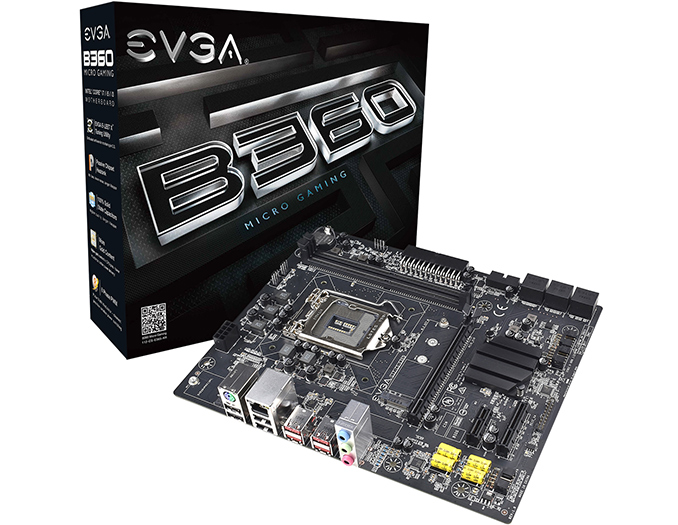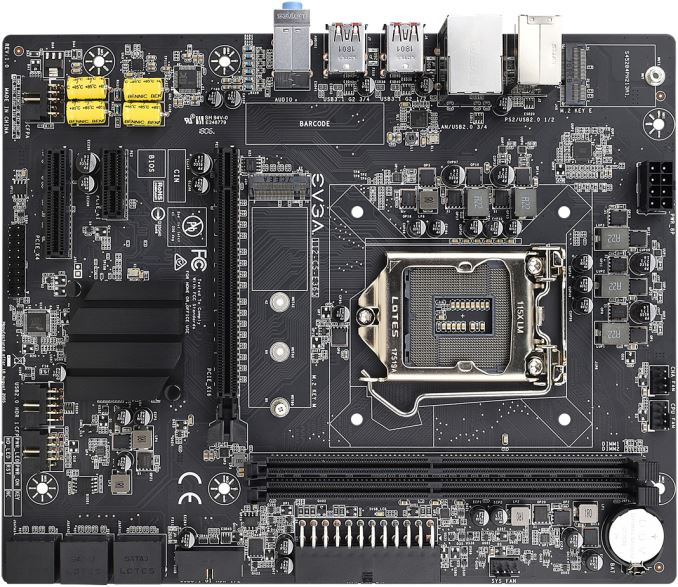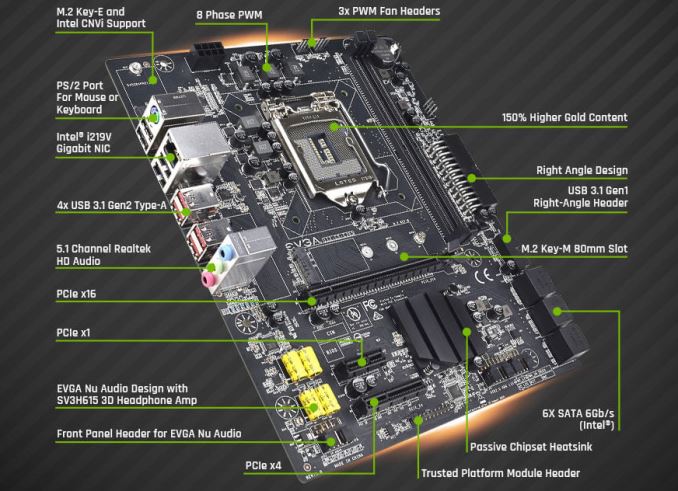EVGA Launches B360 Micro Gaming: Its First Budget Motherboard
by Anton Shilov on October 3, 2018 9:00 AM EST- Posted in
- Motherboards
- Intel
- EVGA
- Coffee Lake
- B360

EVGA on Tuesday officially introduced its first budget-oriented motherboards. The EVGA B360 Micro Gaming is based on Intel’s moderately priced B360 chipset, yet the mainboard supports most of the key features one comes to expect from an EVGA board, with the exception of course of overclocking.
The EVGA B360 Micro Gaming supports Intel’s Coffee Lake processors and is outfitted with an 8-phase PWM that promises a clean and stable power supply to a CPU. Since Intel’s B360 PCH does not support overclocking, the VRM is not covered with a heatsink and was not designed for this in general (though, expect it to handle processors with a default TDP without any problems). One particularly notable thing about the EVGA B360 Micro Gaming is that it does have any display ports, and as a result it cannot use Intel's iGPUs. Keeping in mind that EVGA is a leading supplier of graphics cards and positions its products for gamers who rarely use Intel's graphics, such peculiarity looks relatively logical for the company.
The motherboard has two slots for DDR4 DIMMs and can support up to 32 GB of memory, which is a reasonable limitation for an entry-level Micro-ATX gaming system. When it comes to expansion capabilities, the mainboard has a PCIe 3.0 x16 slot for graphics cards, a PCIe 3.0 x4 slot for high-end SSDs, a PCIe 3.0 x1 slot for other types of add-on-cards, one M.2-2280 slot for SSDs, six SATA hot-plug-capable connectors for storage devices, and an M.2-2230 slot for CNVi 802.11ac Wi-Fi solutions.
Moving on to connectivity. The EVGA B360 Micro Gaming is equipped with Intel’s i219V GbE silicon, four USB 3.1 Gen 2 connectors, four USB 2.0 headers, two USB 3.1 Gen 1 ports available through internal headers, a PS/2 connector, and a 5.1-channel audio subsystem featuring an SV3H615 headphone amplifier, as well as audio-oriented capacitors to enable EVGA Nu Audio through front panel headphone jack.
| EVGA B360 Micro Gaming | ||
| 112-CS-E365-KR | ||
| Supported CPUs | LGA1151 v2 CPUs Coffee Lake |
|
| PCH | Intel B360 | |
| Graphics | PCIe 3.0 x16 slot | |
| Display Outputs | None | |
| Memory | 2 × DDR4 DIMM Up to 32 GB of DDR4-2667 |
|
| Slots for Add-In-Cards | 1 × PCIe 3.0 x16 1 × PCIe 3.0 x4 1 × PCIe 3.0 x1 |
|
| Ethernet | Intel I219V GbE PHY | |
| Storage | 6 × SATA 6 Gbps 1 × M.2 PCIe 3.0 x4 |
|
| Audio | 5.1-channel audio with 3.5-mm outputs, SV3H615 headphone amplifier, EVGA Nu Audio enhancements | |
| USB | 4 × USB 3.1 Gen 2 Type-A 4 × USB 2.0 Gen 2 Type-A Internal headers for USB ports |
|
| Serial Ports | - | |
| Wi-Fi | M.2-2230 slot for CNVi Wi-Fi solutions | |
| Form-Factor | Micro ATX (244 mm × 244 mm | 9.6" × 9.6") | |
EVGA’s B360 Micro Gaming is of course a far cry when compared to the company’s enthusiast-class motherboards based on Intel’s Z370 or X299 chipsets. Nonetheless, the release of such a platform by EVGA indicates that the company is now looking at entry-level gaming machines as a way to expand its business.
The EGA B360 Micro Gaming is available right now directly from the company for $119.99.
Related Reading:
- EVGA Launches X299 Micro ATX 2 Motherboard
- EVGA Goes Budget Part 2: H370 Stinger, with 10 PCB Layers
- EVGA Goes Budget: B360 Gaming Motherboard Coming Soon
- The EVGA X299 FTW K Motherboard Review: Dual U.2 Ports
Source: EVGA












10 Comments
View All Comments
The Chill Blueberry - Wednesday, October 3, 2018 - link
Does are some scary caps for the sound processing!thekaidis - Wednesday, October 3, 2018 - link
The decision to go no IGP goes beyond wanting to sell EVGA video cards (although that's of course part of it.). This way EVGA can run an 8phase power controller in 6+2 mode (6 for core and 2 for mem). If they added the display ports, cost increase wouldn't just be the cost of the port hardware but also of either an additional voltage controller for the IGP, or a VRM heatsink if they instead choose to run 4+2+2.magila - Wednesday, October 3, 2018 - link
Even without IGP support there still needs to be a separate power plane for the other "uncore" bits of the CPU like the memory controller, PCIe controller, etc. So this looks like a 5+1 phase with a 2 phase memory VRM. A 5 phase vcore is still pretty good for a budget board. The 2 phase memory VRM it complete silliness though. This board does not support memory which would even come close to needing more than one phase.austinsguitar - Wednesday, October 3, 2018 - link
are there really that many people buying budget intel systems? like non of their locked cpus are worth it at all compared to the competition?Death666Angel - Wednesday, October 3, 2018 - link
If you don't want to overclock, both still offer good solutions. The i5 8400 is the prefered gaming CPU for many recommendation lists.austinsguitar - Wednesday, October 3, 2018 - link
the r5 2600x is better than that cpu in every scenario. and could even be overclocked, for 20 dollars less? kinda crazy recommendation. not an amd fanboy just stating facts of the lower end.Samus - Wednesday, October 3, 2018 - link
I just build an i7-8600 (non-K) for a video processing DVR using a B360 board, the Asus Gaming whatever. It has wifi and video ports that will never be used, but it is a budget board with a high-end CPU where I needed 6c/12t.Even the guy at Microcenter was like "why not go AMD if you need threads" and the answer was simple: Quicksync. Intel destroys AMD at video encoding because of Quicksync.
This board, presumably, still supports the Quicksync architecture even though it lacks video-out. Since the DVR is setup in a rack without a keyboard or monitor, the missing video output is moot because its all remotely managed anyway, just booting a VMWare USB flash drive to load VM images from the SSD and using 2x8TB hard drives for storage.
All that said, I suspect a lot of people will use this board with the i3-8100 which is a potent gaming CPU for $100. For my application, the 8600 and 8600k were virtually identical in performance because the boost bins are mostly the same when all cores are utilized. It's really just a matter of not using the garbage cooler Intel supplied. Since I put it all in a 2U case, I was able to use a really nice HSF that prevents throttling.
The 8086K on the other hand would have had a noticeable increase in performance, stock for stock, compared to the other i7 8th gen parts.
TheManInBlack - Thursday, October 4, 2018 - link
Of course you do mean an I'5' 8600! Don't you? :)GreenReaper - Sunday, October 7, 2018 - link
I'm not sure it works that way. The video codec is AFAIK part of the graphics hardware, moreso than the CPU side, albeit that it's a bit of an separate block, perhaps even physically.Also, if the BIOS or chipset doesn't enable the CPU's GPU - and it might not, in case it mislead the computer into using it - how is it going to know it needs drivers, or attach them to anything? This is similar to what happened to the Hades Canyon NUC - it wasn't using the CPU's GPU:
https://www.anandtech.com/show/12572/the-intel-had...
This is basically a server motherboard in this regard, and they tend to have separate low-power display hardware as part of the BMC rather than using the CPU (which is often expected not to have one at all). This also increases the CPU side's ability to run at full throttle.
Maybe they have been able to find a compatible way to work this, but I'd want to see it tested first.
PeachNCream - Thursday, October 4, 2018 - link
"...it does have any display ports..."Major miss there for EVGA. It just means that a potentially interested consumer will have to purchase a NVIDIA 1030 or something along those lines to get an image on a screen at extra cost, leaving the iGPU transistors as cold and dead in the CPU socket when they could be busy pushing pixels instead. If you're going to put together a decent budget board, which this otherwise looks like it is, at least have the decency to include a VGA, DVI, or HDMI port. (Don't care about DP since they're so uncommon.)